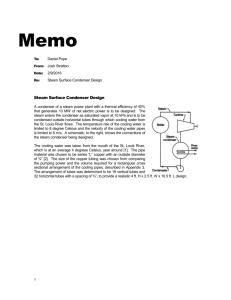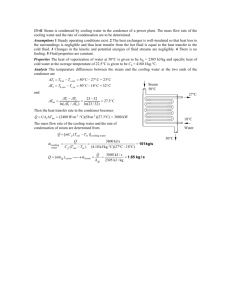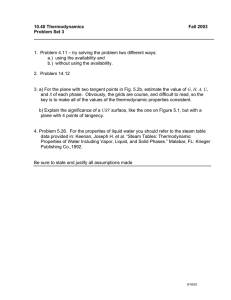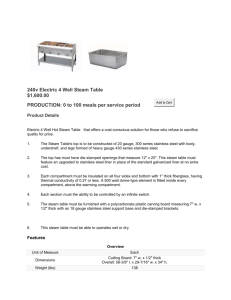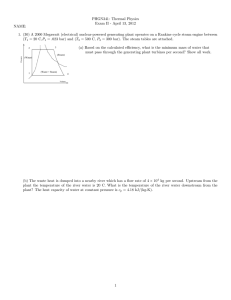Recovery of a multicomponent, single phase aerosol
advertisement
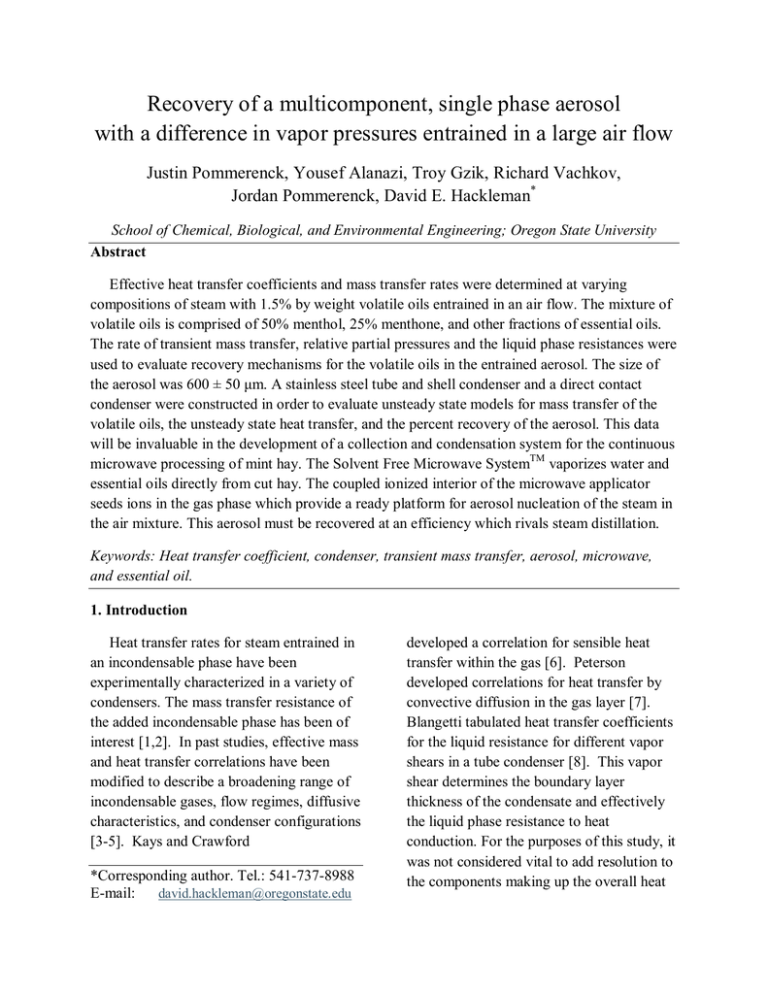
Recovery of a multicomponent, single phase aerosol with a difference in vapor pressures entrained in a large air flow Justin Pommerenck, Yousef Alanazi, Troy Gzik, Richard Vachkov, Jordan Pommerenck, David E. Hackleman* School of Chemical, Biological, and Environmental Engineering; Oregon State University Abstract Effective heat transfer coefficients and mass transfer rates were determined at varying compositions of steam with 1.5% by weight volatile oils entrained in an air flow. The mixture of volatile oils is comprised of 50% menthol, 25% menthone, and other fractions of essential oils. The rate of transient mass transfer, relative partial pressures and the liquid phase resistances were used to evaluate recovery mechanisms for the volatile oils in the entrained aerosol. The size of the aerosol was 600 ± 50 μm. A stainless steel tube and shell condenser and a direct contact condenser were constructed in order to evaluate unsteady state models for mass transfer of the volatile oils, the unsteady state heat transfer, and the percent recovery of the aerosol. This data will be invaluable in the development of a collection and condensation system for the continuous microwave processing of mint hay. The Solvent Free Microwave SystemTM vaporizes water and essential oils directly from cut hay. The coupled ionized interior of the microwave applicator seeds ions in the gas phase which provide a ready platform for aerosol nucleation of the steam in the air mixture. This aerosol must be recovered at an efficiency which rivals steam distillation. Keywords: Heat transfer coefficient, condenser, transient mass transfer, aerosol, microwave, and essential oil. 1. Introduction Heat transfer rates for steam entrained in an incondensable phase have been experimentally characterized in a variety of condensers. The mass transfer resistance of the added incondensable phase has been of interest [1,2]. In past studies, effective mass and heat transfer correlations have been modified to describe a broadening range of incondensable gases, flow regimes, diffusive characteristics, and condenser configurations [3-5]. Kays and Crawford *Corresponding author. Tel.: 541-737-8988 E-mail: david.hackleman@oregonstate.edu developed a correlation for sensible heat transfer within the gas [6]. Peterson developed correlations for heat transfer by convective diffusion in the gas layer [7]. Blangetti tabulated heat transfer coefficients for the liquid resistance for different vapor shears in a tube condenser [8]. This vapor shear determines the boundary layer thickness of the condensate and effectively the liquid phase resistance to heat conduction. For the purposes of this study, it was not considered vital to add resolution to the components making up the overall heat transfer resistance in the tube and shell condenser, since film condensation for the aerosol was unlikely. At system throughputs, condensation was observed to take place via drop nucleation at the steam percentages of interest. Therefore, the overall heat transfer coefficient for turbulent drop nucleation in a tube and shell condenser developed by Colburn [1] and compared for differing steam velocities by Stewart [9] are the most practical. For a steam velocity of 1.9 – 2 m s-1, the overall heat transfer coefficient is shown in Equation (1) [9, converted to SI units] 𝑈 = 161 𝑒 0.0338 𝑌 (1) The overall heat transfer coefficient is U in Wm-2 K-1 and Y is steam percent, valid from 10-99%. Aerosols have been treated to a large extent using steady state, pseudo steady state, and unsteady state analyses. These systems have largely been investigated in stagnant air where evaporation of a multicomponent aerosol occurs via evaporation. The mass transfer involved in evaporation usually convolutes the analytical heat solutions. If the aerosol droplet is very small ~50 µm and the components volatile, the mass transfer rate will be a function not only of concentration potentials but also the temperature profile. If the rate of heat transfer is slower than mass transfer, the system will cool and the evaporation rate will fall with the decrease in partial pressure. Vibrating orifice aerosol generators are used to produce and suspend aerosols in a stagnant air chamber while temperature, composition and size are monitored via elastic scattering diffraction and cavity enhanced Raman scattering [10]. Since prior studies have not dealt with heat and mass transfer from multicomponent large aerosols entrained in an incondensable gas, it was imperative that such data be generated if possible in order to characterize recovery options for microwave enhanced retrieval of essential oils in applications for continuous processing of organic materials. Overall heat transfer coefficients, condensation rates, steady state material balances, and unsteady state mass transfer rates are characterized in order to optimize percent recovery for both a tube and shell condenser and a direct contact condenser. 2. Experimental 2.1. Air/Steam mixture generator A steam generator was created which could recreate an aerosol pattern with oil compositions in steam in the air mixture encountered in the field tests. Figure 1 shows the in-field Solvent Free Microwave Extraction SystemTM. A metal hood of dimensions 70 cm wide by 1.07 m long and tapered to a width of 10 cm at a height of 20 cm was acquired in the lab. A 6 m3 min-1 max flow rate fan was mounted to the top of the hood at one end and delivered flow to a 10 cm diameter metal duct. This hood was mounted to a superstructure made of fir “2x4’s” (4cm x 9cm) and plywood. The hood was spaced 38 mm above a table top made of plywood and the 1.07 m sides were covered with “2x4’s” to constrain air flow into the hood to only through the two 70 cm by 38 mm gaps to imitate the microwave system air inlet. The hood system can be seen in Figure 2. The in-field process flow diagram is depicted in Figure 3. An adjustable globe valve distributed 172 kPa steam from building basement pipelines to four, 66 cm long, 1.9 cm diameter galvanized pipes spaced 16.5 cm apart. These pipes were sealed at the end and had six, 1.6 mm diameter holes drilled in each, spaced evenly 10 cm apart along the pipe length. This steam delivery system was placed under the hood at the end near the fan. The fan attached to the hood withdrew the aerosol at a constant rate so the steam to air ratio could be adjusted by opening or closing the globe valve. Cooling Water Vent Air Steam + Air Aluminum Tube and Shell Condenser 75 kW ~ Figure 1: In-field microwave applicator operates at 100 kW with an energy compensator and dispersive reflector. The microwave efficiency is 85%. Microwave traps are at the exits. Oil Water Microwave Oil Separator Thickness Adjuster 1 m min-1 0.14 m3 min-1 10 kg min-1 Hay Receiver Conveyor Hay Conveyor Spent Hay Exit Conveyor Waste Transport Figure 3: The process flow diagram for the in-field microwave applicator which is being simulated at one fourth scale in the laboratory. The fan ducting was then routed into either of the characterized condenser systems. The steam in the air mixture was collected and its size distribution recorded. An injector was used to distribute the oils into the steam prior to the collection system. 2.2 Tube and Shell Condenser Figure 2: Laboratory steam generator unit creates an aerosol ten times larger than the average aerosol in the microwave applicator. This simulates one of the four microwave hoods. A tube and shell condenser was acquired from Newhouse Manufacturing in Redmond, Oregon, to characterize the capture of the essential oils. The condenser consisted of five, 1.6 cm diameter inner tubes which the steam passed through and were enclosed in a 15.25 cm diameter shell in which cooling water passed through. The condenser was 1.5 m in height and made of schedule 316 stainless steel. The Newhouse Manufacturing condenser can be seen in Figure 4. flow rate of 24 dm3 min-1 and entered the condenser at 12.9°C. Varying steam to air ratios were passed through the condenser and condensate volume over time was measured for each vapor ratio as well as the temperature traveling through the ducting which was measured at the fan exit. A process flow diagram for the tube and shell condenser system is shown in Figure 5. Temperature probes, a rotometer, and anemometer gave continuous data during each of the 15 runs. Thermocouple Steam in Water in Thermocouple Figure 4: The laboratory steam generation system is attached to the stainless steel tube and shell condenser by a 3 m fan duct. Cold water flowed past the six tubes of steam and air. Condensed steam out Water out The steam and air mixture was delivered from the 10 cm ducting into a 1.25 cm tube that fed the vapor mix into the condenser. The cooling water was run countercurrent to the vapor mixture through a 0-35 dm3 min-1 rotometer into the condenser shell via a 2 cm “garden” hose. Temperatures of the cooling water inlet and air mixture in the duct from the fan were measured with type K thermocouples and the VernierTM data acquisition system. The vapor flow rate was found to be 0.116 m3 min-1 out of the condenser. Vapor velocity was 2.8 m s-1. Cooling water was maintained at an inlet Thermocouple Anemometer Thermocouple Figure 5: The laboratory test system is shown with sensors in place, inlets, and outlets. A recovery receptacle was placed beneath the condenser gas exit. 2.3 Direct Contact Condenser A SHURflo® M8000 high pressure electric diaphragm pump was used to recycle the water sprayed by the direct condenser into the entrained air mixture. A bypass valve was used to adjust the pressure at the sprayer tips. TeeJet TP8002 visiFlo ® flat tip sprayers were used to spray water into the direct contact heat exchanger. The number of spray tips varied from 2 to 8 during tests. The spray pressure set up the mist spray characteristics. At low pressures, the mist fan was not fully developed. At high pressures, the fan was fully developed and the mist developed into micro droplets after colliding with the opposite wall of the direct contact condenser. The experimental setup is shown in Figure 6. and condensed steam in the direct contact condenser during the timed trials. The entrance to the direct contact condenser is through the top of the white PVC pipe. The test flow diagram is shown in Figure 7. Hood Steam 5 m3 min-1, 70oC Sprayer 200 kPa, 25oC Rotometer Anemometer Thermocouple Outlet Water 1.6 dm3 min-1 Thermocouple Scale Figure 7: A depiction of the direct contact condenser, air/steam mixture generator and associated instrumentation in trial position. Figure 6: The direct contact condenser with two spray nozzles and the 6 dm3 min-1 pump attached to the bypass valve and pressure gauge. Inlet steam velocity was measured with a Vernier Instruments anemometer. Temperature out of the hood and out of the direct contact condenser were recorded continuously. The change in temperature during mixing of the steam and air within the hood gave the steam to air ratio. This ratio was also corroborated by physically condensing all of the steam and measuring the air flow rate separately. An industrial Rice Lake Class III digital scale was used to determine the accumulation of cooling water Sprayers were placed opposite on the same level and rotated around the tube as more spray levels were added. Spray flow rates were calibrated at pump pressures registered after the bypass valve. Calibration of the spray flow rate varied by 2-3% with higher variations at the higher flow rates. Steam was passed downward through 2, 4 and 8 sprayers. The steam and air mixture exited from an exhuast hole 10 cm in diameter through a VernierTM anemometer. The trial run at 24% steam does not begin to recover steam as soon as the trial run at 22% steam because the four sprayers were replaced with eight sprayers which needed a greater pressure head or flow rate of cold water in order to begin developing the spraying pattern. heat transfer resistance was compared to the results of Colburn [1]. Some key results are shown in Table 1. 3. Results and discussion U= 3.1 Heat transfer An energy balance and ratio of densities were used to find the steam to air ratio and mass of steam entering into the system. The energy balance was made with the control volume around the hood. Adiabatic heat transfer was assumed so that the temperature of the gases coming out of the hood would give the steam to air ratios based on the heat capacities of the steam and air as well as the inlet temperatures of the steam and air. The air entered the hood at a temperature of 20.2°C and the steam entered the hood at 100°C. The energy balance yields Equation (2). The adiabatic energy balance on the steam and air will under-predict the inlet steam. . m steam . m air = Cpair (Tmix − Tambient ) Cp steam (Tsteam − Tmix ) ( mC ∆T ) p CW (3) A ( ∆TLM ) Where CW refers to the cooling water and LM the difference between the wall temperature and the cold water. Steam mass / Kg 0.46 0.24 Overall heat transfer coefficient U (this study) /(W m−2 K −1 ) 147.0 68.0 Overall heat transfer coefficient U (Colburn) /(W m−2 K −1 ) 136.1 64.7 Table 1: The temperature and flow rate of cooling water were used to obtain heat transfer coefficients. Differences in the predicted heat transfer coefficients for a stainless steel condenser largely arose from differences in the flow configuration. Steam velocities for this study were 30% larger than in Stewart [9]. (2) Where m is the mass flow rate, Cp is the Specific Heat and T the temperature. The accuracy of these assumptions was evaluated by physically condensing the steam in a cold reservoir and measuring the air flow rate using a VernierTM anemometer. These values were used in order to calculate overall heat transfer coefficients. The effective heat transfer coefficient was calculated using the sensible heat change of the cooling water and the driving force as the difference in the wall temperature and the cold water temperatures. The effective 3.2 The aerosol at steady state conditions If the oil were to transfer from the vaporized aerosol into the air phase before the condenser, heat transfer resistance from the entrained air would be compounded by mass transfer losses of the oil. Assuming that the dilute volatile oils can be represented as ideal at the equilibrated state, a Henry’s law equation could predict the concentration remaining inside the large aerosol after an infinite amount of residence time within the collection system. Upon reaching the condenser, this remaining essential oil inside the aerosol would be condensed. The recovery at equilibrated conditions was determined for each steam composition. ̂flv = ̂fll (4) 𝑦𝑀𝑂𝐻 𝑛 𝑇𝐴𝑖𝑟 + 𝑥𝑀𝑂𝐻 𝑛 𝑇𝐿𝑖𝑞 = 𝑛𝑀𝑂𝐻 (6) yMOH P = xMOH HMOH y MOH P = nMOH − yMOH nTAir H MOH nTLiq (5) (7) Where f is the partial molar fugacity, 𝑥𝑀𝑂𝐻 the liquid and yMOH the vapor phase menthol fraction, n the number of moles, P the pressure, H the Henry’s constant and subscript T the term “total”. This maximum in percent recovery is simulated without the ideal solution and ideal gas assumptions using UNIFAC. Menthol 50% by weight was assumed to represent the volatility of the oils in the aerosol. The results agree to within 7%. Recovery of oils at equilibrated conditions would be limited to 25% even with complete capture of the aerosol. This would eliminate virtually all recovery of the essential oils using any type of condenser. The equilibruim result is shown in Figure 8. 3.3 Mass transfer at unsteady state conditions Dynamic time calculations versus the concentration in an aerosol bead were performed using Navier-Stoke’s conservation of mass with several valid simplifications. First, the aerosol size did not change with time. Since the air was measured at 100% humidity, there would be no mass transfer potential for the water in the aerosol to transfer into the air phase. Secondly, the liquid phase resistance to heat transfer is orders of magnitude smaller than the gas phase resistance to heat transfer. The temperature gradient of the aerosol can be assumed to remain constant with time. Also, since there is no evaporation of the water which is the bulk of the aerosol, the evaporation of the essential oils, which are 1.5% by weight, represents an insignificant removal of heat from the aerosol. Menthol is 0.25% by weight in the air. Even if it were fully concentrated in the gas phase, the gas phase resistance to mass transfer may be neglected. The aerosol is shown in Figure 9. CMOHo DMOH-H2O CMOH∞ Figure 9: The aerosol drop pictured has no net transfer of water to the 100% humidity bulk air. The bead is approximately isothermal since any thermal losses due to evaporation of 1.5% menthol is small compared to the specific heat of the bulk water in the aerosol. Unsteady state menthol diffusion from the aerosol into the bulk air can be predicted. Figure 8: The ChemCAD model used to determine equilibruim composition of the liquid which would be recovered by a perfect condenser. CMOH ( −1)n n π r − D = −C Ao sin ∑ e π r n =1 n R 2R ∞ n π t 2 MOH − H 2O R 2 2 (8) CMOH -3 (Kg m ) Figure 10: The total oil content within the vaporized aerosol varies as a function of position within the vaporized aerosol and with the residence time it spends in the microwave collection unit. The figure shows the aerosol’s essential oil composition radially for any chosen residence time and can be used to determine maximum possible yield. At the residence time of the aerosol within the in-field collection system, the maximum possible oil yield is 88% for complete steam recovery. Possible recovery is not limited by a partial pressure problem because equilibrium is not established with the air in the collector until 13 seconds after the aerosol is sent into the condenser. The ion density inside the microwave applicator sets up the size of the aerosol which determines the point when the aerosol’s mass transfer losses become a significant problem. 3.4 Tube and Shell Condenser Results Tube and shell recovery mirrored the heat transfer predictions of Colburn [1,2]. Total recovery of the steam entrained in the air mixture was possible at 64% steam by mass. Below this value, there was insufficient area and too high a steam velocity for complete recovery. The preexponential constant will change with system design and cooling water flow rate which was increased dramatically from that of previous studies. Colburn [1, 2] has outlined general design considerations for tube and shell condensers. The recovery of the aerosol in the tube and shell condenser at 22% steam by mass is shown in Figure 11. 1 Steam Recovery Fraction The solution to Navier-Stoke’s conservation of mass equation with these simplifications yields Equation (8). The transient changes in oil concentration throughout an aerosol bead within the isothermal collection unit are shown graphically in Figure 10. Diffusivity was calculated using the Wilke-Chang correlation and an approximation was made for the atomic volume of the oil [11]. 0.8 0.6 0.4 0.2 0 0 20 40 60 80 Mass of Steam / % Figure 11: Experimental results of the tube and shell condenser. Recovery = 14.9e0.0315 Y. (R2 = 0.92). The steam recovery has the same exponential relationship to steam percent that was presented by others [1, 2, and 9]. 3.5 Direct Contact Condenser Results The direct contact condenser more than doubled recovery upon doubling spray flow rate. Recovery in the direct contact condenser for reasonable cold water rehydration flow rates exceeded that of the tube and shell condenser which will certainly be unable to capture the smaller Solvent Free Microwave aerosol. The direct contact condenser improves drastically with increasing spray flow rate. The percent recovery for the direct contact condenser with 8 spray nozzles operating at three total fluid flow rates is shown in Figure 12. The experiment was performed with a fluid pump with a maximum flow rate of 6 dm3 min-1; hence it was not possible to operate the set of 8 spray nozzles beyond that flow rate. 1 Steam Recovery Fraction Recovery of steam is proportional to the overall heat transfer coefficient. The power is 0.0315 compared to 0.0338 found in the literature [1, 2]. This exponential constant is believed to be smaller based on the increase in steam velocity in this study over that of Colburn from 2.0 m s-1 to 2.8 m s-1 [9]. The pre-exponential constant is a function of cooling water flow rate set at 24 dm3 min-1 and can be dimensionally transferred into units of the overall heat transfer coefficient based on the cold side energy transfer. 0.8 0.6 0.4 0.2 0 2 3 4 5 Spray Flow Rate / dm3 min-1 6 Figure 12: Steam recovery in direct contact condenser with 8 sprayers at 24% steam by mass. Recovery = 3E-05 e1.921 Y, (R2 = 0.87). It can be seen that as the spray from each nozzle develops from a moderate stream of droplets into a more desired mist of micro droplets, the capture efficiency increases. Therefore recovery could be improved by optimizing the sprayer design and operating point. As demonstrated in Figure 13, until the nozzles achieve “fan spray”, the capture efficiency is very low. Large improvements in capture efficiency have been shown to be a function of spray development which can be widened to include spray angle, the contact velocity, and the effective residence time of the steam. This means key empirical relationships quantifying the effect of these three parameters need be undertaken. Steam Recovery Fraction 1 be increased by improving the microwave collection steam percent. It also indicates that a continuous, open microwave extraction system is feasible despite having very low steam percent since the steam percent only affects the stagnation recovery at the maximum spray flow rate and not the development of the spray pattern. 0.8 0.6 0.4 0.2 0 2 3 4 5 6 Spray Flow Rate / (dm3 min-1) Figure 13: Results of the direct contact condenser. The circular markers correspond to 4 sprayers at 22% steam by mass in the stream flow; squares are 8 sprayers at 24% and triangles 8 sprayers at 47%. The change in recovery shows that as one increases the number of spray nozzles from 4 to 8, the efficiency of capture increases at a rate in agreement with residence time in the spray region through the combination of a reduced volume due to cooling and reduced total volume of air/steam due to condensation of steam. There is a plateau capture efficiency which depends on the spray rate when the spray is fully developed. Also, the capture efficiency of the direct contact condenser is less affected by the concentration of steam than by the development of the spray. The concentration of steam does affect the plateau recovery at maximum spray flow rate. It was demonstrated that an initial exponential increase in spray flow rate occurs due to the development of the spray pattern. This spray pattern sets up the type of droplet capturing the steam. The second factor affecting steam recovery is the percent steam by mass. This determines the probability of capture by a single droplet. Thus, for any spray type such as micro droplet spray, the maximum percent recovery at a specific flow rate can It is important that not only spray type and drop capture probabilities be considered in order to improve recovery. The effectiveness of a single droplet in condensing the steam will be a function of its total energy content. This condensation capacity can be examined using a steady state energy balance. Assuming adiabatic condensation, a transient energy balance can be performed for each of the direct contact condenser trials to determine the overall energy transfer from the steam to the mist. 𝑚̇𝑠𝑡𝑒𝑎𝑚 ∆𝐻𝑣 = 𝑚̇𝑤𝑎𝑡𝑒𝑟 𝐶𝑝 ∆𝑇 𝑇2 = 𝑇2 = 𝑚̇𝑠𝑡𝑒𝑎𝑚 ∆𝐻𝑣 + 𝑇1 𝑚̇𝑤𝑎𝑡𝑒𝑟 𝐶𝑝 0.56 𝑘𝑔 min−1 2300 𝑘𝐽 𝑘𝑔−1 + 290 𝐾 5 𝑘𝑔 𝑚𝑖𝑛−1 4.18 𝑘𝐽 𝑘𝑔−1 𝐾 −1 𝑇2 = 78 ℃ As the steam percent increases, the need for cooler spray temperatures increases. The mint oil, 1.5% by weight in the large aerosol, was recovered in the condensate and formed a viscous layer in the direct contact condenser. Samples were taken for GC analysis. In future work, an aluminum direct contact condenser will be fabricated in order to investigate mass transfer losses from a 60 μm aerosol. Acknowledgements Sincere thanks to the Mint Industry Research Council. Also, Newhouse Manufacturing Co. provided the stainless steel condenser used in the aerosol heat transfer trials in a laudable cooperative effort for the development of an alternative essential oil extraction tool. References [1] A.P. Colburn, O.A. Hougen, Bull. Univ. Wisc. Expt. Sta., 70 (1930). [2] A.P. Colburn, O.A. Hougen, Ind. Eng. Chem. 26, (1934) 1178. [3] A. Briggs, S. Sabaratnam, Int. J. Energy Res. 27 (2001) 301-314. [4] S. Kuhn, V. Schrock V., P. Peterson, Nuc. Eng. & Des. (1997) 177. [5] T. Wu, K. Vierow, Int. J. Heat and Mass Trans. 49 (2006). [6] W. Kays, M.E. Crawford, Convective Heat and Mass Transfer. McGraw-Hill, New York, 1993. Chapters 8 and 14. [7] P.F. Peterson, V.E. Schrock, T. Kageyama, J. Heat Trans. 115 (1993) 9981003. [8] F. Blangetti, R. Krebs, E.U. Schlunder, Chem. Eng. Fund. 1 (1982) 20-63. [9] P. Stewart, J. Clayton, B. Loya, S. Hurd, Ind. Eng. Chem. Proc. Des. Dev. 3 (1) (1964) 48-54. [10] R. Hopkins, J. Reid, J. Phys. Chem. B, 110 (2006) 3239-3249. [11] J.R. Welty, C.E. Wicks, R.E. Wilson, G.L. Rorrer, Fundamentals of Momentum, Heat, and Mass Transfer. Wiley, Hoboken, NJ (2007).
